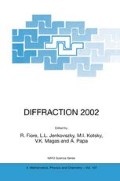Abstract
An approach to inelastic diffraction based on the concept of equivalence of diffractive states is presented. Intermediate transitions inside the equivalence class yield a multi-channel correction which can be factorized producing the diffraction amplitude in the form NΔt, to be taken in the Bjorken-like ‘diffractive limit’: N → ∞, Δt → 0 such that NΔt is finite. We analyse the contribution of inelastic diffraction to elastic scattering of elementary hadrons and light nuclei, in the range of c.m. energy √s= 20 — 1800 GeV. This is done in the framework of a semi-phenomenological model where the diffractive states are built of a two-hadron bulk and some quanta (‘diffractons’) describing diffractive excitations. The single minimum observed experimentally is explained as an interference effect due to scattering off ‘diffractons’, present inside the hadronic bulk.
Access this chapter
Tax calculation will be finalised at checkout
Purchases are for personal use only
Preview
Unable to display preview. Download preview PDF.
References
Frahn, W. E. (1985) Diffractive Processes in Nuclear PhysicsClarendon Press, Oxford.
Glauber, R. J. (1959) High-Energy Collision Theory, in W. E. Brittin and L. G. Dunham(eds.)Lectures in Theoretical Physicsvol.1Interscience, New York, pp. 315–414.
Akhiezer, A. I. and Sitenko, A. G. (1957) Diffractional Scattering of Fast Deuterons by NucleiPhys. Rev. 1061236–1246.
Chou, T. T. and Yang, C. N. (1968) Model of Elastic High-Energy ScatteringPhys. Rev. 1701591–1596.
Etim, E., Malecki, A. and Satta, L. (1987) A New Definition of the Diffractive Limit with Applications to pp and pp ScatteringPhys. Lett. B18499–104.
Malecki, A. (1989) The Real and Imaginary Part of the Elastic Scattering Amplitude in High Energy DiffractionPhys. Lett. B221191–193.
Malecki, A. (1991) Inelastic Diffraction and Equivalence of StatesPhys. Lett. B267523–526.
Malecki, A. R. (1996) Diffractive Limit Approach to Elastic Scattering and Inelastic Diffraction of High Energy HadronsPhys. Rev. D543180–3193.
Glauber, R. J. (1955) Deuteron Stripping Processes at High EnergiesPhys. Rev. 991515–1516.
Malecki, A. (1991) Nuclear and Partonic Dynamics in High Energy Elastic Nucleus-Nucleus ScatteringPhys. Rev. C44 R1273–1276.
Goulianos, K. (1983) Diffractive Interactions of Hadrons at High EnergiesPhys. Rep. 101169–219.
Good, M. L. and Walker, W. D. (1960) Diffraction Dissociation of Beam ParticlesPhys. Rev. 1201857–1860.
Bialas, A., Czyż, W. and Kotański, A. (1972) A Model of Diffractive Production in Hadron-Hadron CollisionsAnn. of Phys. 73439–460.
Schubert, K. R. (1979) Tables of Nucleon — Nucleon Scattering, Landolt-Börnstein, New Series, Vol. 1/9aSpringer, Berlin.
Satta, L. et al. (1984) Elastic Scattering of α Particles on Light Nuclei at p α = 7 GeV/cPhys. Lett. B 139263–266.
Author information
Authors and Affiliations
Editor information
Editors and Affiliations
Rights and permissions
Copyright information
© 2003 Springer Science+Business Media Dordrecht
About this chapter
Cite this chapter
Małecki, A.R. (2003). Multiparticle Dynamics of Hadron Diffraction. In: Fiore, R., Jenkovszky, L.L., Kotsky, M.I., Magas, V.K., Papa, A. (eds) DIFFRACTION 2002: Interpretation of the New Diffractive Phenomena in Quantum Chromodynamics and in the S-Matrix Theory. NATO Science Series, vol 101. Springer, Dordrecht. https://doi.org/10.1007/978-94-010-0177-9_18
Download citation
DOI: https://doi.org/10.1007/978-94-010-0177-9_18
Publisher Name: Springer, Dordrecht
Print ISBN: 978-1-4020-1307-2
Online ISBN: 978-94-010-0177-9
eBook Packages: Springer Book Archive

